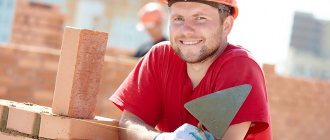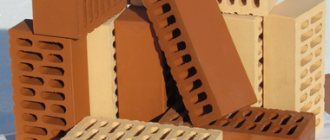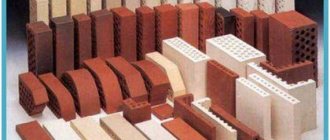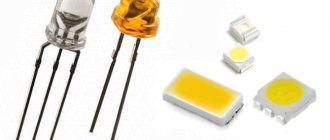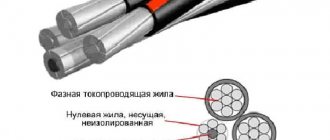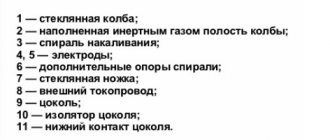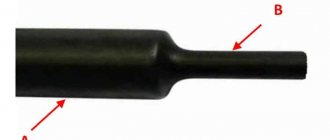One of the material options for facing work around the house is a hollow type of brick.
This material has become very popular and is used not only for cladding, but also for the construction of buildings and the construction of partitions inside the house.
One of the most common external coatings is cladding - the application of a continuous sealed outer layer of a specialized material that performs all the necessary functions and takes on external loads.
Description of facing hollow bricks
The main feature that characterizes hollow bricks is through holes and cracks, which come in various shapes. There are both round, oval, and square, rectangular void shapes.
The percentage of voids reaches 50%, the smallest number of them is 12%. This point suggests that during production a significantly smaller amount of material is used, in contrast to the full-bodied variety . Due to this product it is cheaper and the production process is faster.
The products are characterized by the fact that in the process of its creation they achieve maximum porosity of the structure. This gives the material a lower thermal conductivity, which means the products better transfer heat at different temperature levels inside and outside the house.
NOTE!
Considering that brick has a large number of voids, this gives it good heat and sound insulation properties . However, to achieve the best possible qualities, it is necessary to control the thickness of the mortar during the laying process and not apply it to voids in the product.
Types of hollow bricks
By type of predominant raw material:
- Clay: red ceramic;
- clinker;
- dry pressed.
- sand-lime brick.
- hyperpressed types.
According to their purpose, hollow bricks are divided into the following groups:
- Private or construction worker. For the construction of external walls and internal partitions. This group also includes a porous ceramic block, in which, thanks to a special firing method, additional heat-saving pores are formed.
- Facial. For cladding facades, interior and exterior decoration.
- Foam diatomite. Used in conditions of elevated temperatures.
According to the method of arrangement of voids:
- vertical through;
- horizontal closed.
Advantages and disadvantages
The advantages of the material are as follows:
- high level of thermal insulation . This indicator should be a priority when purchasing a product. This advantage allows you to provide a comfortable microclimate in the house, regardless of the weather and season;
- if you lay brick in two rows, then there is no need to use material to insulate the walls;
- long-term operation . The product has sufficient strength and resistance to negative environmental factors. The service life reaches 50 years without loss of its properties;
- high noise insulation . The voids that the brick contains provide not only thermal insulation properties, but also relieve homeowners from external noise. Such a brick creates a kind of shield that prevents the spread of sound;
- opportunity to save on consumables . Considering that the material itself is cheap and has good thermal insulation, then: firstly, you do not need to purchase a large amount of it for cladding, and secondly, you will need much less mortar than with ordinary brick;
- not subject to cracking . The air contained inside the brick allows the material to remain intact throughout its entire service life. In particular, products with a proportional ratio of voids and raw materials of 1:1 have this property;
- good decorative properties . This advantage is as significant as all the previous ones. With the help of hollow bricks, you can improve your home and create an attractive appearance of the facade.
The disadvantages of the product include:
- with its help it is not possible to build a foundation, since the brick does not have a sufficient level of strength;
- it is also characterized by hydrophilicity due to its significant porosity;
CAREFULLY!
Brick absorbs moisture well and over time, with the onset of winter, can lead to cracking of the material due to liquid frozen in it.
Advantages and disadvantages
Solid artificial stone has great strength and frost resistance. You can find this type of brick with technical voids. They are necessary to reduce internal stress during the firing process.
The full-bodied, low-porosity look is manufactured without voids. Thanks to this, it has low moisture absorption (within 8%) and high thermal conductivity.
Its disadvantage can be called its low heat-protective performance. To reduce heat loss and brick consumption, it is best to use well masonry when constructing walls. This type of masonry means that the masonry of the walls looks like two independent walls, having a thickness of half a brick. To connect them, vertical and horizontal bridges are laid out, forming closed wells. Next, the resulting wells must be filled with slag, lightweight concrete and expanded clay.
Another disadvantage is the unattractive appearance of the walls. The surface laid out on it will be rough. Therefore, internal and external walls will need to be plastered.
A common brand of solid brick is M125. The brand indicates the degree of strength of the product; the higher it is, the stronger the material.
Specifications
First of all, products are divided into grades from M125 to M250, which characterize its strength indicator.
Other technical specifications are as follows:
- thermal conductivity varies from 0.16 to 0.24 W/m*Co;
- density level from 1100 to 1700;
- frost resistance indicators 35-35.5 F;
- percentage of water absorption 6-8;
- weight varies from 2.2 to 3.4 kg.
The choice of material for walls in low-rise construction
The most important step in building a house, on which the possibility of using various construction technologies, future design and architecture depends, is the correct choice of building material.
Of all its diversity, for the construction of a low-rise building, a number of main ones can be identified - these are wood, brick, various concrete structures and blocks of cellular concrete. Wood is considered a traditional material that has been in great demand throughout the world for many centuries. With the improvement of technology, the quality of constructed wooden objects has also improved. Now, many people increasingly prefer a house made of rounded logs, timber or frame construction. The latter is the cheapest and most practical option for low-rise construction.
External wall thickness
When building a wooden house, the thickness of the outer wall depends on the physical dimensions of the wood itself. They mainly use inexpensive logs with dimensions of 25–30 cm or timber 15–20 cm thick. In view of this, the maximum thickness of a wall from an average homogeneous massif does not exceed 20 cm, which does not meet the standard for thermal conductivity of enclosing structures, so additional insulation is required. Most often, mineral wool is used as insulation.
When building a house from gas silicate blocks, the recommended thickness of the wall with brick cladding is 40 cm, which fully meets all standards.
Brick
Depending on the production technology and their composition, bricks are divided into silicate and ceramic, solid and hollow, as well as porous.
Main selection criteria:
- Load-bearing capacity and strength
- Resistance to frost, moisture and heat
- Thermal conductivity
- Manufacturability of the material (practicality in use, speed of laying)
- Price
Sand-lime brick
Sand-lime brick is used for the construction of enclosing structures and internal walls, but due to a number of disadvantages, its use was officially banned in Moscow.
Sand-lime brick is very susceptible to water and heat. It absorbs moisture well, and then, under its influence, begins to crumble. Therefore, foundations, stoves, fireplaces, etc. cannot be laid from it.
As for thermal conductivity, sand-lime brick has a heat transfer coefficient of about 0.7–0.8 W/m o C, this is higher than that of solid red brick 0.5–0.6 W/m o C, but lower than dense structure concrete 1.2–1.5 W/m o C. Depending on the strength, seven grades of sand-lime brick are distinguished: M-75, M-100, M-125, M-150, M-200, M-250, M-300. Brands are also distinguished by frost resistance: F-15, F-25, F-35, F-50. It follows from this that high-quality brick has good strength and high resistance to frost. Also, the advantages of sand-lime brick include its increased soundproofing qualities and low price.
Ceramic brick
There are two types of ceramic bricks: facing and building. Due to different production technologies, facing bricks are not afraid of moisture and cold. It is used for finishing facades and internal partitions, and it is also a good protection against external adverse conditions for building bricks.
By strength, facing bricks are divided into: M-100, M-125, M-150, M-170, M-200, M-250 and M-300, and by frost resistance into: 25, 35, 50 and 75.
Red solid ceramic brick
Solid brick has low cost, high strength, but insufficient thermal conductivity of 0.4–0.6 W/m o C, so additional thermal insulation is required. For example, a wall of one and a half bricks is insulated with a 10 centimeter layer of mineral wool. The main use of solid brick is the construction of load-bearing walls.
Depending on the required thickness, brickwork is made in different ways. It can be half a brick, a brick or one and a half bricks.
If support for domestic structures is required, a brick column is used. Its thickness is determined by the height of the object, that is, the higher the object, the thicker the column.
Efficient ceramic brick
Effective ceramic bricks come in two types: porous and non-porous.
Non-porous brick has a low thermal conductivity coefficient of 0.35–0.4 W/m o C, but still requires additional insulation measures. The load-bearing capacity of such bricks is low.
Hollow bricks are produced in two ways: plastic molding or semi-dry pressing. Due to multiple voids (from 13% to 55%) in its mass, the brick manages to achieve ideal density. Depending on the strength of hollow bricks, the following grades are distinguished: M-75, M-100, M-125, M-150, M-175, M-200, M-250 and M-300. And depending on frost resistance, there are grades: 15, 25, 35, 50 and 75. Hollow brick is used for laying external and internal walls.
Porous brick has good processability, high strength, excellent sound insulation and a very low thermal conductivity coefficient of 0.2-0.27 W/m o C. It is produced either in the form of double bricks or in the form of large stones.
Cellular concrete blocks
This group of building materials includes foam concrete, aerated concrete or gas silicate blocks. It is worth noting that blocks made of cellular concrete have proven themselves in the construction of low-rise buildings.
In the production of foam concrete blocks, a composition is used that at normal temperatures begins to harden in forms, and special chemicals are added to create a porous structure.
In the production of gas silicate concrete, the following composition is used: sand, lime, cement and aluminum powder. When the mixture reaches the desired state, it is cut into the required sizes and sent to an autoclave heated to 200 o C, where it acquires its unique properties. Aerated concrete blocks, with the same density as foam concrete, have higher strength and a lower thermal conductivity coefficient.
Main competitors
Based on the above, two main competitors can be distinguished: porous ceramic bricks and cellular concrete blocks.
Porous building materials are 30–40% inferior in thermal conductivity to blocks made of cellular concrete, but they are 3.5–4 times superior in strength. Therefore, when building loaded houses, developers prefer to choose warm ceramics, which are also more attractive in appearance.
Kinds
- ceramic _ The material is made from clay raw materials. Produced with a smooth surface, textured finish, and a layer of glaze. All of the above options are used to impart decorative properties to the product;
- clinker _ This variety also belongs to ceramic, but it is more modern due to the fact that special types of clay raw materials and the firing process are used in production. Due to such nuances, a reliable material for cladding is obtained; it is mainly used for situations with large and constant loads;
- hyperpressed . No firing is used during production. It is replaced by high pressure pressing. Due to the technological process used to create it, the finished products have a natural stone surface. This makes it possible to realize the most original design ideas. The main disadvantage of the product is the high level of thermal conductivity;
- silicate _ It is the cheapest material for cladding, but its appearance is not very attractive. This is precisely the reason why it is used less and less as a facing material.
Classification of Hollow Bricks
In the modern world, the following types of hollow bricks are distinguished according to the shape of the holes in them:
- with oval holes;
- with round ones;
- with square;
- with rectangular ones.
The material is also divided into types according to purpose:
- if there is a relief pattern on the building material, then it can be used for the construction of decorative fences;
- building material with beveled corners or rounded edges is used for the construction of vaulted structures and arrangement of arched passages.
Hollow bricks are made using various firing technologies:
- in ring furnaces;
- in tunnel kilns.
This building material is made from various raw materials:
- clay;
- cement.
Characteristics of hollow bricks, according to which the material is also divided into groups:
- thermal conductivity coefficient of hollow bricks, a low indicator is achieved due to the presence of cavities in the building material;
- firing temperature;
- degree of porosity.
Hollow bricks are divided into groups according to the method and material of manufacture:
Porous. This building material is used for facing work. The porous structure significantly reduces the weight of hollow bricks. Among the advantages are high rates of thermal insulation and sound absorption.
Double porous brick
Thermally efficient. This material allows you to significantly save money on construction. Its thermal insulation properties allow it to be laid not in two, but in one row. The relatively low weight of the building material significantly lightens the wall structures, which in turn place less load on the base of the building. Maintains the required temperature in the home both in winter and summer.
Thermally efficient hollow brick
Cement-sand. As the name implies, cement, sand and various binding components are used to make this material. Since clay is not needed for its production, the material is almost half the price. The peculiarities of its manufacture do not affect the thermal insulation value; the sound insulation of hollow cement bricks is the same as that of clay bricks.
Cement sand hollow brick
Foam diatomite. This building material is used for the construction of buildings that in the future will be constantly exposed to high temperatures, for example blast furnaces or smelting furnaces. Such bricks can also be used in conventional construction, but this is simply an extra expense.
Foam diatomite hollow brick
Ceramic. This type of material has an attractive appearance and high thermal insulation properties. It can be used for external and internal work.
Ceramic hollow brick
Manufacturing companies
There are quite a lot of manufacturers of hollow facing bricks.
The most popular and widespread of them are:
- Kerma, made in Russia;
- KS-Keramik, Russian production;
- Proomax, Russian made;
- Daas Baksteen, made in Holland.
Masonry process
The process of laying hollow bricks is presented below, it can be described by the following algorithm:
- initially they establish procedures;
- after this, they tighten the moorings, which are necessary to ensure even laying of the brick material;
- This is followed by dry laying of the brick material on the wall.;
- preparing the solution;
- laying the mortar on the wall;
- its distribution under the outer mile;
- after this they carry out the laying of the outer mile;
- spread the required amount of mortar under the inner mile and begin laying it;
- then apply the solution under the forget-me-not and lay it down;
- check the correctness of the masonry rows.
NOTE!
To carry out a high-quality process, it is necessary to use a solution with a mobility index not exceeding 8 cm. This will avoid the loss of a large amount of the composition if it flows into the voids of the product and prevent deterioration in thermal conductivity.
An important point in the process is regular measurement and verification of the masonry level.
Masonry calculation
Do-it-yourself masonry is insurance against hackwork and a big saving of your money. Before starting work, it will be useful to review the theory and read SNiP (Building Norms and Rules). If your building meets the established requirements, this will help to officially accept it into operation.
Stability calculations are made based on the classification specified in the documentation. Remember that stability depends on thickness and height.
The thicker it is, the better. To avoid undesirable phenomena, carefully read paragraphs 6.16 – 6.20 of SNiP II-22-81. The tables provide data and calculation methods that will help you do everything correctly.
When deciding on masonry, pay attention to some things:
- Load on the wall (this affects the number of storeys of the building). Climate (it is necessary to ensure not only strength, but also proper thermal insulation). Aesthetic factor (for example, masonry made of a single brick will look much more elegant than one made of one and a half and double bricks).



